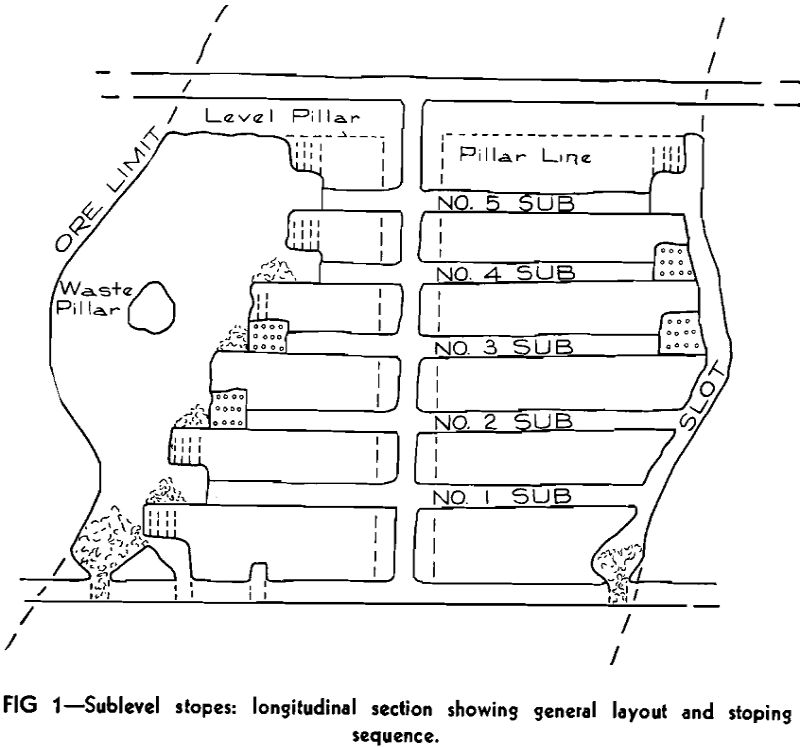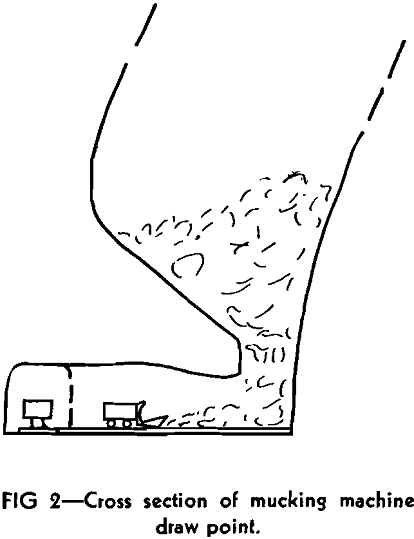Sublevel stoping was first developed in the Michigan iron mines many years ago. Since that time this method, and modifications with long hole drilling, have been used in a number of non-ferrous mines and have been described in various papers and articles. With a few exceptions, the operations where sublevel methods have been applied are producers of large daily tonnages from ore bodies of considerable size. In selecting mining methods for small properties or relatively small detached ore bodies, sublevel methods often have been overlooked.
Applicability
Since this is an open stope method, it requires wall rock that will stand over reasonable stope lengths without caving or excessive slabbing. Ore must be moderately firm but need not be hard.
The method is best adapted to steep dipping, tabular or lenticular ore bodies but may be applied to ore bodies of almost any shape if their vertical extent is appreciable. It can be used with dips that are too flat for successful shrinkage stopes and can be modified for use with slushers on dips below about 40°.
Initial mining at the Copper Canyon operation consisted of sublevel stopes for the wider ore sections and shrinkage stopes for the narrow sections where ore widths averaged about 15 ft. After some experience and a study of comparative results on completed stope blocks, sublevels were substituted for shrinkage stopes even in the narrow ore widths.
Stoping Details
Preliminary development for sub-level stoping would be simple. A service raise is driven at about the center of the block and stope limits planned to leave a pillar around this raise. Sublevel drifts driven each way from this central raise will outline the

end limits of the ore shoot at various elevations. Stoping will start from the ends of the sublevels and retreat toward the central pillar.
Haulage Level Development
On the haulage level, draw points are laid out so that all of the ore can be pulled when broken. The type of chute or draw point selected determines the elevation of the first or lowest sublevel.

At Copper Canyon our first stope layouts used grizzlies over timbered chutes with one or two finger raises feeding each grizzly. After some experimenting we found that the least expensive and generally most satisfactory draw point consisted of a crosscut driven at about a right angle from the haulage drift with a finger raise from the crosscut face.
Sublevels
Sublevels above the first one are driven from the raise at vertical intervals of about 23 ft. Our first sublevels at Copper Canyon were driven with a large cross section to help produce initial mill ore tonnage. Best overall results were obtained later with small drifts driven on a 5 to 8 pct grade. Drift rounds were drilled with stopers, thus reducing the number of types of machines and steel in service. Mucking was done with slushers, scraping to the service raise chute.
Stoping
Stoping is started at the end of the block opposite the service raise by excavating a slot across the stope over the first finger raises and extending upward to the top sublevel. At first our mining slots were narrow, transverse shrinkage stopes with access from the sublevels. As we gained experience, the slots were started by driving a series of short raises to connect the ends of the sublevels. Since each lift takes only two or three rounds, driving is fast and inexpensive. This raise is then enlarged by benching from the sublevels until a slot from wall to wall is excavated. The enlarged tops of the first fingers form the bottom of this slot.
The ore is blasted into an empty open stope so that gravity, to some extent, helps the fragmentation. Broken ore rolls down the footwall so that the method may be used when dips are flat enough to cause considerable difficulty in drawing shrinkage stopes.

